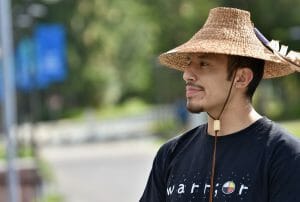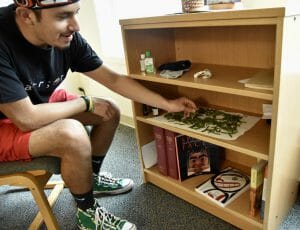Sealaska established a $10 million language endowment to focus on the revitalization of Tlingit (Lingít), Haida (X̱aad Kíl) and Tsimshian (Sm’algya̠x) languages. In Alaska, very few birth speakers of these traditional languages remain. All are older than 70, and a majority are 80 or older. The group includes four birth speakers of Sm’algya̠x, three birth speakers of X̱aad Kíl, and 63 birth speakers of Lingít. We invite you — all 23,000 of our shareholders — to get involved in this important effort to revitalize our languages. If you ever had an interest in learning your language, NOW is the time. Sealaska’s $10 million Language Revitalization Fund is expected to generate $500,000 in grants annually to invigorate Indigenous languages over the next decade.
This is the first part of a miniseries that will follow Joseph Hillaire as he studies X̱aad Kíl. Hillaire is Lummi and Haida and his Haida name is Nang Sk’at’aas.

College student Joseph Hillaire Jr. has taken a giant leap and pushed himself outside of his comfort zone. After three years at Northwest Indian College in Bellingham, Washington, for an environmental science degree, he changed his academic path and is now studying X̱aad Kíl (Haida language).
Hillaire is one of 17 scholars enrolled at the University of Alaska Southeast (UAS) in the Haa Yoo X̱’atángi Deiyí: Our Language Pathway program, which was established by Sealaska Heritage Institute with a goal of developing more heritage language speakers.
This immersive three-year program is for Alaska Native students who plan to teach their language: Lingít Yoo X̱’atángi (Tlingit), X̱aad Kíl (Haida) or Sm’algya̠x (Tsimshian). These language scholars receive a full scholarship to UAS that includes room, board, tuition and other expenses. In return, the hope is that scholars, in coordination with SHI and the Southeast Regional Language Committee, will create a suitability plan to address gaps in culture based Indigenous language.
Hillaire’s rich connection to X̱aad Kíl began in high school. At his high school graduation in 2017, he was a keynote speaker and did his entire speech in X̱aad Kíl. His mentor Lisa Ka’illjuus Lang guided him with his words to his fellow classmates and community.
“I am so proud of the path he is taking in life,” says Lang. “I had the honor of working with him as he wanted to learn and give his Hydaburg High School graduation speech in X̱aad Kíl (Northern Alaskan Haida). He worked so hard to learn his speech. He dressed in his finest regalia (made by his Aunties) and gave a beautiful and thoughtful speech in X̱aad Kíl. He truly touched everyone’s heart that day.”
Getting Comfortable

When Hillaire was applying for the Haa Yoo X̱’atángi Deiyí language program, he realized this was a tremendous opportunity. “The questions being asked in the application were like a wake-up call for me,” says Hillaire. “My goals with language revitalization became more of a reality and this was a meaningful way to continue the important work for our languages.”
Completing the journey through the language program is bringing a new environment and a new academic direction for Hillaire.
While attending Northwest Indian College in Bellingham, Washington, he was surrounded by his Lummi Nation family. Hillaire knows he’s most comfortable surrounded by family and familiarity. He’s exploring new ways to feel comfortable while attending University of Alaska Southeast (UAS) over the next few years. Hillaire enjoys exploring the many trails on the UAS campus. While in his campus apartment, Hillaire also listens to his album collection — LPs like Led Zeppelin’s debut album from 1969 help him feel at home. He says listening to Haida recordings, listening to his record player, and cooking brings him a peaceful state of mind.
Support From the Community
Although Hillaire has only been in the program since early September, he gives the experience a “C” grade. He says the grade is based on the experience. “This is a big change for me, coming from a tribal college,” says Hillaire. “I feel there is a difference in the way the academic year is set up — I had three quarters, and at UAS I have semesters.”

Lang says she’s been fortunate to watch Hillaire gracefully go from high school to successfully attend Northwest Indian College and now on to an amazing experience in Alaska to further his language skills.
“All I can say is that I am truly amazed by his determination and effort,” says Lang. “He knows that the community will continue to support his language pathway of learning. We wish him and all the scholars well in their language learning. In Hydaburg, like all Haida everywhere, we feel the urgency and critical nature in saving our highly endangered language.”
Dedication Toward Our Language Pathway Program
The SHI language scholars will attend UAS full-time and commit to live in a language immersive environment, fully devoting their learning to their heritage language for three years.
- Each scholar will complete four, 300-hour (20 hours weekly) internship rotations: two classroom and two community organization rotations.
- Heritage language scholars will host two community language learning sessions a year, which are open to the public.
- Scholars will also participate in an annual Summer Language Institute at the end of each spring semester.
The program is largely supported through nearly $1.9 million in funding over three years secured by SHI. Language revitalization has been a priority of SHI’s board of trustees since the 1990s, according to SHI President Rosita Worl.
“We’ve made a lot of progress since we began focusing on language revitalization,” Worl said, noting the numerous language instructors now teaching in public schools across the region. “However, we must provide these immersive habitats to ensure that we grow the number of teachers and perpetuate our languages, which are the foundation of our culture.”
Hillaire says he’s excited about reaching the end of the program with his fellow scholars.
“We are not in this alone — we are a team,” said Hillaire. “I’m a family-orientated person and I believe that all of our accomplishments are made by ourselves, but we are all working towards the same goal. It’s almost like winning a game but having that feeling of all the teamwork pay off and celebrating with all the three cohorts.”
Learn more about the Haa Yoo X̱’atángi Deiyí: Our Language Pathway program https://www.sealaskaheritage.org/node/1187
About Sealaska’s Investment in Traditional Languages
In 2019, Sealaska established a $10 million language endowment to focus on the revitalization of Tlingit (Lingít), Haida (X̱aad Kíl) and Tsimshian (Sm’algya̠x) languages. We anticipate spending $500,000 annually for the next 10 years to support advanced learners.
Sealaska invests in language preservation through the endowment fund and a yearly commitment to Sealaska Heritage Institute (SHI). Since 1980, Sealaska has donated roughly $33.7 million to SHI.